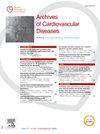Involvement of platelet factor 4 in myocardial ischemia/reperfusion
IF 2.3
3区 医学
Q2 CARDIAC & CARDIOVASCULAR SYSTEMS
引用次数: 0
Abstract
Introduction
Ischemia/reperfusion injury (IRI) is a key process in the initiation of post-infarction pathological remodeling. Several studies demonstrated that platelets play a major role in the development of IRI due to their abundance at ischemic sites. Platelet activation leads to the secretion of platelet proteins, some of which (TGF-β, PDGF,..) are already involved in pathological ventricular remodeling. Among these, platelet factor 4 (PF4) is the most abundant chemokine and has already been implicated in the development of fibrosis in tissues such as the lung and skin.
Objective
To evaluate the role of platelet factor 4 (PF4) in cardiac fibroblasts differentiation and the subsequent development of cardiac fibrosis. Additionally, to determine whether targeting PF4 could serve as an innovative therapeutic strategy using human anti-PF4 monoclonal antibodies developed in our laboratory.
Method
First, characterization of the effect of platelet factor 4 on cardiac fibroblasts primary culture by assessing fibrosis markers in normoxia condition or subjected to oxygen and nutrient deprivation stress. For therapeutic purposes, human anti-PF4 monoclonal antibodies previously developed in our laboratory (1E12, 1C12 and 5B9) were used to target the effect of PF4 in the differentiation of fibroblasts into myofibroblasts.
Results
Our results show that PF4 (5 μg/mL) induces a significant increase in α-sma (alpha-smooth muscle actin) expression in cardiac fibroblasts, under normoxic conditions as well as under conditions of nutrient and oxygen deprivation. Treatment of cardiac fibroblasts with a therapeutic concentration of heparin, which can interact with PF4 and is used as first-line therapy in post-infarction patients, had no effect on the PF4-induced increase in α-sma expression. However, anti-PF4 monoclonal antibodies significantly reduced the expression of the fibrosis marker expressed by FP4-induced cardiac fibroblasts.
Conclusion
This study demonstrates the role of PF4 in the differentiation of cardiac fibroblasts towards the myofibroblastic profile, which initiates fibrosis. Furthermore, the use of anti-PF4 antibodies decreases PF4-dependent cardiac fibroblast differentiation in normoxia and under conditions of nutrient and oxygen stress, suggesting a potential innovative strategy for targeting fibrosis associated with pathological left ventricular remodeling after myocardial infarction.
血小板因子4在心肌缺血/再灌注中的作用
缺血再灌注损伤(ischemia /reperfusion injury, IRI)是梗死后病理重构开始的关键过程。几项研究表明,血小板在缺血部位的丰富,在IRI的发展中起着重要作用。血小板活化导致血小板蛋白的分泌,其中一些(TGF-β、PDGF等)已经参与病理性心室重构。其中,血小板因子4 (PF4)是最丰富的趋化因子,并且已经与肺和皮肤等组织的纤维化发展有关。目的探讨血小板因子4 (PF4)在心肌成纤维细胞分化及纤维化过程中的作用。此外,为了确定靶向PF4是否可以作为一种创新的治疗策略,使用我们实验室开发的人抗PF4单克隆抗体。方法首先,通过评价常氧条件下或缺氧营养剥夺应激下的纤维化指标,探讨血小板因子4对心肌成纤维细胞原代培养的影响。为了治疗目的,我们使用实验室先前开发的人抗PF4单克隆抗体(1E12, 1C12和5B9)来靶向PF4在成纤维细胞向肌成纤维细胞分化中的作用。结果在缺氧和缺氧条件下,PF4 (5 μg/mL)诱导心肌成纤维细胞α-sma (α-平滑肌肌动蛋白)表达显著升高。肝素可与PF4相互作用,是心肌梗死后患者的一线治疗药物,用治疗浓度的肝素治疗心肌成纤维细胞对PF4诱导的α-sma表达升高无影响。然而,抗pf4单克隆抗体显著降低了fp4诱导的心脏成纤维细胞表达的纤维化标志物的表达。结论本研究证实PF4在心肌成纤维细胞向肌成纤维细胞分化过程中起作用,从而引发纤维化。此外,抗pf4抗体的使用降低了在缺氧和营养和氧应激条件下pf4依赖性心脏成纤维细胞的分化,这表明针对心肌梗死后病理性左心室重构相关纤维化的潜在创新策略。
本文章由计算机程序翻译,如有差异,请以英文原文为准。
求助全文
约1分钟内获得全文
求助全文
来源期刊

Archives of Cardiovascular Diseases
医学-心血管系统
CiteScore
4.40
自引率
6.70%
发文量
87
审稿时长
34 days
期刊介绍:
The Journal publishes original peer-reviewed clinical and research articles, epidemiological studies, new methodological clinical approaches, review articles and editorials. Topics covered include coronary artery and valve diseases, interventional and pediatric cardiology, cardiovascular surgery, cardiomyopathy and heart failure, arrhythmias and stimulation, cardiovascular imaging, vascular medicine and hypertension, epidemiology and risk factors, and large multicenter studies. Archives of Cardiovascular Diseases also publishes abstracts of papers presented at the annual sessions of the Journées Européennes de la Société Française de Cardiologie and the guidelines edited by the French Society of Cardiology.
 求助内容:
求助内容: 应助结果提醒方式:
应助结果提醒方式:


